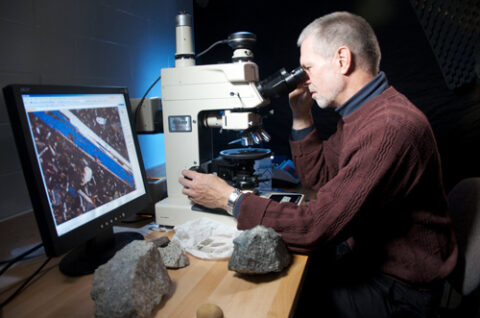Mineralogist Robert Hazen loves exploring rocks and minerals, not just because of their spectacular colors and shapes or because they form the building blocks of modern civilization, but for what they can teach us about the origin and evolution of life on Earth.
A new NOVA science television program that launches on Public Broadcasting System (PBS) stations tonight explores the idea that life and rocks have coevolved for most of the 4.5 billion years of the planet’s history. “Life’s Rocky Start,” produced by WGBH-TV in Boston, Mass., for PBS, darts between outcrops in Australia’s outback, mineral-rich hydrothermal vents, the United States’ Yosemite National Park, a collection of meteorites in a Moroccan marketplace, and scientific laboratories, among other venues, in a quest to explore this coevolution.
“We’ve thought for centuries [that] animals, minerals—they’re separate kingdoms, right. But it turns out they overlap, they’re intertwined, they coevolve.”
“We’ve thought for centuries [that] animals, minerals—they’re separate kingdoms, right. But it turns out they overlap, they’re intertwined, they coevolve,” says Hazen on the show. “You can’t separate the two.”
“Nothing seems more lifeless than a rock. It’s inanimate. It’s the antithesis of a living thing. But we are beginning to realize that rocks played an absolutely fundamental role in the origin of life,” adds Hazen, a research scientist at the Carnegie Institution of Washington’s Geophysical Laboratory in Washington, D.C.
The television program follows Hazen and other scientists as they examine how Earth went from a lifeless rock to a living planet. The show divides Earth’s history into six stages, mirroring the outline of Hazen’s 2012 book The Story of Earth: The First 4.5 Billion Years, from Stardust to Living Planet. It moves from “black Earth,” with volcanoes spewing lava and covering the planet with basalt, to “blue Earth,” in which oceans form and water plays a key role as a solvent enabling various molecules to interact. In another stage, photosynthesis looms large on the “red Earth.” Ultimately, passing through the first five stages, the program reaches “green Earth,” reflecting the rise of the terrestrial biosphere.
As the stages unfold, the television program provides examples for the coevolution of life and rocks. For instance, the narrator states that during the black Earth period, some ingredients needed for life already were present in the rocks. The program also explores chemical experiments to recreate the early Earth “cocktail” of rocks and minerals that produced organic compounds. It mentions, as well, Hazen’s suspicion that two thirds of all minerals now on Earth were created by the introduction of oxygen.
Elaborating on Coevolution
In an interview with Eos, Hazen elaborated on the coevolution of rocks and life. “It’s really not that complicated to say that life and rocks coevolve. But what allowed us to say this in a more rigorous, quantitative detail was large databases of minerals that we’ve been analyzing and building.”
Those analyses show, he added, that “indeed, individual mineral species arise from processes that can only result from a living planet,” such as the rise of oxygen, root systems, and the decay of vegetative matter.

Each mineral species, particularly the rare ones, is telling a story, “that the near-surface environment has been radically modified by life” and that those minerals would not occur on another world that did not have a similar kind of biosphere, he said. “Not only did life originate in part because of the chemistry that minerals can do, [but] then minerals arise because of the chemistry that life can do,” he added. The show looks at a number of minerals, including calcite, which is the primary component of limestone and forms mainly from shells and other remnants of marine organisms.
“Not only did life originate in part because of the chemistry that minerals can do, [but] then minerals arise because of the chemistry that life can do.”
The program concludes with a look at how humans are transforming the planet by building cities and changing the compositions of the atmosphere and oceans. Hazen told Eos that human activities in this current geological period, which many scientists refer to as the “Anthropocene” because of humanity’s influence, are fundamentally changing surface chemistry, geochemical cycles, and how minerals are created and become distributed. New minerals have formed, for instance, on the walls of smelters, on acid mine drainage dumps, in piles of abandoned slag, and in landfills, he said.
Hazen said that he is not passing judgment on these human impacts. “I think that as soon as you are thought to be an advocate for one political position or another, it weakens your science. So I’m just observing.”
However, he encourages scientists to study human impacts to enable them to “inform debates” about the ethical, health, or sustainability aspects of these changes.
—Randy Showstack, Staff Writer
Citation: Showstack, R. (2016), New NOVA TV show explores coevolution of rocks and life, Eos, 97, doi:10.1029/2016EO043495. Published on 13 January 2016.
Text © 2016. The authors. CC BY-NC 3.0
Except where otherwise noted, images are subject to copyright. Any reuse without express permission from the copyright owner is prohibited.

